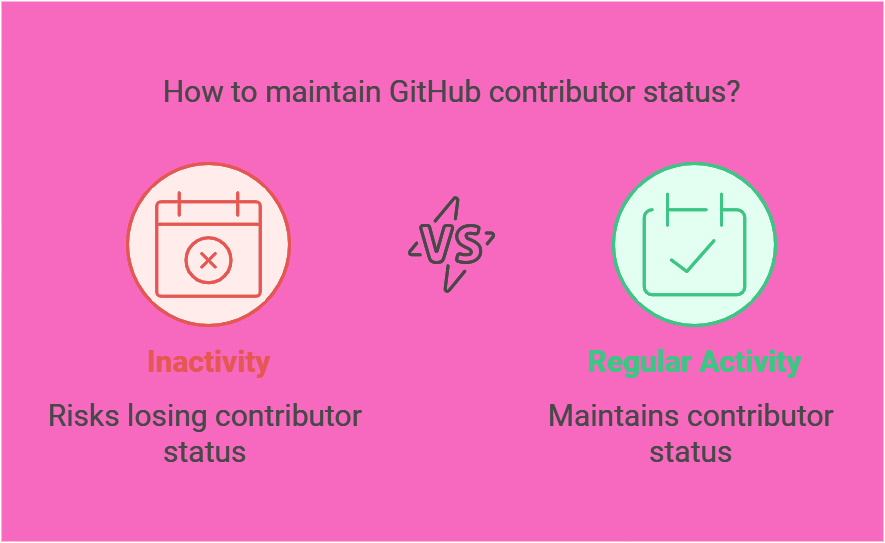Discover how GitHub tracks contributions and whether inactivity affects your status as a contributor. Learn practical tips to maintain visibility and stay active in the GitHub community.
Does Inactivity on GitHub Remove Your Contributor Status?
In the modern landscape of software development, GitHub has become the cornerstone for collaboration. It provides a platform for developers to work on projects, manage code, and build innovative solutions together. However, one persistent question has intrigued many contributors: “If you don’t push to a repository for a long time, does that mean you’re no longer considered a contributor?”
This article explores this question, delves into the technical aspects of how GitHub recognizes contributions, and offers practical tips for maintaining your contributor status.
How GitHub Tracks Contributions
GitHub uses specific metrics to track contributions. Contributions are recorded through the following activities:
- Code Pushes: Every push to a repository—whether it’s adding new code, fixing bugs, or updating documentation—counts as a contribution.
- Pull Requests: Submitting pull requests to suggest changes or improvements is a significant way to contribute.
- Issue Management: Opening, closing, or commenting on issues also counts toward your contributions.
- Repository Activity: Creating or forking repositories, managing branches, and tagging releases are other activities that GitHub tracks.
These activities form the basis of the contribution graph visible on your GitHub profile. But what happens when you’re inactive for an extended period?
Are You Still a Contributor Without Recent Activity?
The short answer is yes. Even if you haven’t pushed code in a long time, you remain a contributor to a repository as long as your previous contributions exist in its history. However, there are nuances to consider:
- Contributor Recognition: If your commits or pull requests are merged into the repository, your status as a contributor remains intact. Your name is listed in the repository’s contributors section.
- Activity Visibility: While your contributions are preserved, an inactive profile may appear less engaged to potential collaborators or employers. This is especially relevant in open-source communities where ongoing participation is highly valued.
- Contribution Graph: GitHub’s contribution graph only highlights recent activity. If you’ve been inactive, your graph will show gaps, but your historical contributions remain unaffected.
The Importance of Regular Contributions
Maintaining regular contributions has several advantages:
- Improved Visibility: Frequent contributions keep your profile active, increasing your visibility within the GitHub community.
- Skill Enhancement: Regularly contributing to repositories hones your coding, debugging, and collaboration skills.
- Community Trust: Active contributors are often seen as reliable and dedicated, building trust in open-source communities.
- Career Opportunities: Employers often review GitHub profiles to gauge a candidate’s expertise. An active profile leaves a stronger impression.

Scholars of Finance: Empowering the Future of Finance Education and Industry
Tips for Sustaining Contributions
Here are practical ways to stay active and relevant as a GitHub contributor:
- Set Contribution Goals: Aim to make at least one meaningful contribution per week or month, depending on your schedule.
- Collaborate on Open-Source Projects: Join open-source communities and contribute to projects that align with your interests.
- Work on Personal Projects: Create and maintain personal repositories to showcase your skills.
- Engage with Issues: Comment on, resolve, or open issues in repositories you care about.
- Keep Documentation Up-to-Date: Contribute by improving or adding documentation, which is often overlooked but highly valuable.
What Happens if You Go Inactive?
If you’re unable to contribute for a long time, here’s what you should know:
- Your Contributions Are Permanent: As long as the repository exists and retains its history, your contributions remain recorded.
- Reactivating Is Simple: Returning to a project is as easy as submitting a new pull request or pushing updated code.
- Community Reengagement: If you’re returning after a long absence, consider reaching out to the repository maintainers to reconnect and understand the current state of the project.
Conclusion
Your status as a contributor on GitHub is not determined solely by your recent activity. Historical contributions remain part of the repository’s legacy, ensuring your efforts are recognized. However, regular contributions enhance your profile’s visibility and relevance, especially in open-source communities and professional settings. By staying active, you not only maintain your contributor status but also foster growth as a developer and build lasting relationships within the tech community.
FAQs
1. Does GitHub remove my name as a contributor if I’m inactive for a long time?
No, your name remains in the contributors’ list as long as your contributions are part of the repository’s history.
2. Will my contribution graph show gaps if I’m inactive?
Yes, your contribution graph reflects only recent activity. Extended inactivity will result in visible gaps.
3. Can I regain visibility after a period of inactivity?
Absolutely! Resuming contributions will update your graph and showcase your renewed engagement.Inactivity on GitHubInactivity on GitHubInactivity on GitHubInactivity on GitHubInactivity on GitHubInactivity on GitHubInactivity on GitHubInactivity on GitHubInactivity on GitHubInactivity on GitHubInactivity on GitHub
4. Do non-code activities count as contributions?
Yes, activities such as issue management, commenting, and updating documentation are recognized as contributions.
5. How can I stay active on GitHub without major time commitments?
Focus on small, meaningful contributions like fixing typos, improving documentation, or resolving minor issues.

